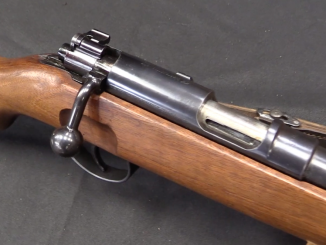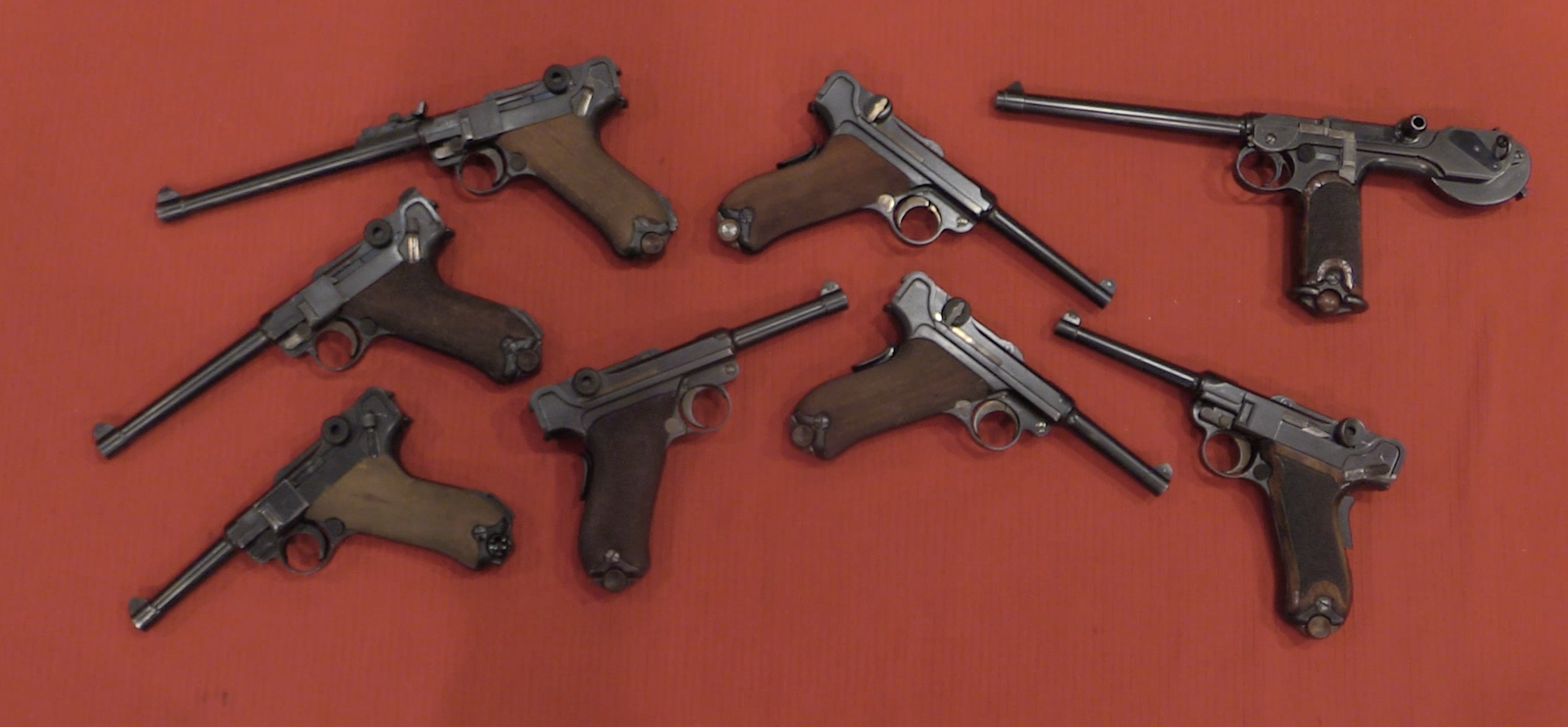This is lot #3569 in the upcoming RIA Premier Auction. It was scheduled for April, but has been postponed – check their web site for upcoming Online Only auctions every month, though!
The lP08 (Lange pistole 08) was formally adopted in 1913 to replace the Reichsrevolver for the field artillery. These were the German light artillery troops, who were specifically given a pistol caliber carbine to provide maximum firepower in a very compact package. They were made by the Erfurt Arsenal in 1914, and by DWM throughout the war, with a total of about 180,000 made.
What is most interesting to me is the evolution of the use of the “artillery Luger” throughout the course of World War One. Starting as simply a compact weapon for artillery, it was quickly recognized by aviators as an ideal weapon for aircraft before the mass introduction of aerial machine guns. The stock allowed more accurate fire, and the semiautomatic operation minimized the handling movements required to fire. More substantially, it was adopted by the German Sturmtruppen for maximizing the striking power of small and flexible units. It is for these men that the 32-round drum magazine was developed in 1916. This represents one of the very few formal military uses of a pistol-caliber semiautomatic carbine, as it was superseded by the advent of the submachine gun in 1918.
A few small batches were made in the 1920s and 1930s, but it would not see significant use in World War Two – leaving it a weapon specifically iconic to the Great War.




One wonders how much was really gained by full-auto capacity in ‘machine-carbines.’ The problems of controlability and ammunition expenditure seem like a deficit in exchange for the spraying capacity. I think it was one of Ian’s vids that pointed out that even expert users like U.S. special forces normally default to semi-auto.
Of course, if it was MY ass on the line, I’d probably want the greatest possible amount of lead downrange.
Keep in mind that during trench warfare stage of Great War/Western Front very close range fire-arms fire was often used. Note that U.S. users seems to be quite content with their shotguns providing similar scatter effect at even shorter range than 9×19 sub-machine guns.
Well, at least according to C&Rsenal (who are not quite the academic source, but are a few step above the anecdotes) shotguns on the front line were a) incredibly rare (50 shotguns issued per division) and b) notoriously unreliable with the paper ammo (yes they ordered all-brass ammo but it arrived only in 1918). So I wouldn’t call it “content”.
Needless to say, anyone hit by a buckshot shell in trench range isn’t going to feel too great. If you took the blast right in the arm at spitting distance, YOU LOST THAT ARM!!
In trenches there are only laws of kill or be killed, no alive armless victims remain, so its kinda irrelevant.
“(…)incredibly rare (50 shotguns issued per division)(…)”
This is surprising for me, I might got wrong impression due to German reaction at time, when they promptly delivered diplomatic note that basically shotgun usage violates Hague Conventions and any soldier captured with it would be executed.
https://www.historynet.com/the-1918-shotgun-protest.htm
This embassy rerouting makes me wonder if information channel distorted the message to the point that somebody added or misinterpreted initial message, for example maybe they did not threat with execution of shotgun wielding prisoners.
I suppose the “reason” that Germany wanted American shotguns banned was that someone equated plated buckshot to EXPLODING bullets intended to inflict a “cruel and unusual death” upon victims (I mean RIPPING PEOPLE APART ALIVE and leaving them to die slowly and painfully).
Not “even” but “exactly” experienced and trained users prefer a single fire.
And yesterday’s farmers are trying to “fill everything with lead” by burning barrels and quickly losing ammunition.
I met the mention of the threat of “execute everyone with a shotgun” …
But this was never carried out, because in response it was promised “to execute everyone with a flamethrower.”
So we agreed … 😉
Instead, they cut off the ears of those who were caught with a sapper bayonet …
Therefore, such “lucky ones” did their best to get the usual bayonet or even sawed off the teeth on the existing ones.
Maybe the best gun for trench fighting would’ve been a drum-fed Thompson, but of course they would not’ve been available.
“All Quiet on the Western Front” mentioned that the weapon of choice in a crowded trench-fight was the ENTRENCHING TOOL, handled like a battle axe.
Actually the German light artillery in the Kaiser War was the 7.7cm gun. The standard French gun was 75mm, the US (originally) and Russians, 3 inch (76mm) and the British Horse Artillery’s 13 Pounder was 3 inch (76mm) and Field Artillery’s 18 pounder was 3.3 inch (84mm). Note that the Royal Artillery also fielded some 4.5 inch and the Germans the 10.5 cm howitzer in the same weight class. Centuries of experience had taught the most manageable team to be 6 horses (3 teams) and that the largest gun and limber they could tow was about 3 inch. German Coastal Artillery belonged to the Navy.
Not mentioned is the Mauser stocked pistol and the Schnell Pistolen fully automatic weapon which were in the same class
One of the primary weapons of the storm troops was the sick grenade and a bunch were often carried in a sandbag slung over each shoulder and secured with the tunic’s epaulettes I’ve got a hunch the spare nine snail magazines were carried the same way. https://www.planetfigure.com/threads/first-post-german-wwi-stormtrooper.81581/
Exactly.
Or rather a club.
The club has maneuverability and speed like a knife, but it goes much further.
And in a club, ammo never ends.
The grenades weren’t sick, but they had sticks for handles !
This article is very useful information and I must say thanks to the author who shared this valuable information with us
I wonder what the practical reliability of the artillery Lugers was like?
The rake angle of the magazine in the grip relative to the feed lips, requires a stronger magazine spring compared to a less raked mag. Mud and gum result in failures to feed
The bolt and toggle also result in less time for a cartridge to rise into the feed lips compared to a browning type slide
My own experience over the years with Lugers (unfortunately neither with artillery length barrels, nor with trommel mags), is that when they start to get dirty, the toggle begins to need a bit of help to fully go into battery.
It would be interesting to know whether the firing order was bang, squeeze the toggle shut, bang…
The same problems are also present in the Lahti M40, not that it ever got a trommel mag or long barrel. A coffin mag adaptation would be ultra cool.
A short open bolt carbine, with a good wooden stock together with a very short bayonet would be much easier to use
Unfortunately the early SMGs seem to have been longer than you’d want in a trench, where entrenching tools and trench clubs seem to have been the very effective weapons of choice.
Keith, did you use military grade ammunition? And did you keep the insides of the gun clean? Mud on the outside is clearly not going to make the thing jam. Check out a Luger mud test.
Ammunition was typically new Sellier & Bellot, so, yes, correct full pressure, FMJ loads,
Not neutered American loadings, dreamed up due to fear of liability claims.
The Spetsnaz stills believes in a sharpened entrenching tool and practices throwing them like tomahawks. And guess who we have, https://www.youtube.com/watch?v=EIGIBJeRfnQ and https://metaproducts.com/cart
One thing that’s sometimes forgotten is that wsr has been described as “hours of boredom pumctuated by moments of sheer terror” so the occupants of the trenches had plenty of time to dream up and build some god-awful stuff. https://www.youtube.com/watch?v=mWH6e4zqEYs
I suspect that the (effectively one armed) Kaiser’s preference for the Parabellum carbine as a sporting rifle had something to do with the adoption of the Artillery.